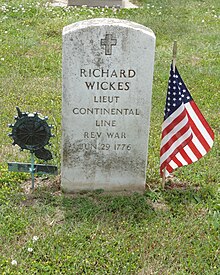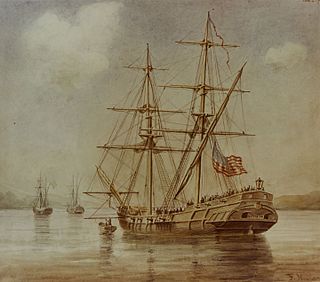
The first USS Lexington of the Thirteen Colonies was a brigantine purchased in 1776. The Lexington was an 86-foot two-mast wartime sailing ship for the fledgling Continental Navy of the Colonists during the American Revolutionary War (1775–1783).

David Bushnell , of Westbrook, Connecticut, was an American inventor, a patriot, one of the first American combat engineers, a teacher, and a medical doctor.
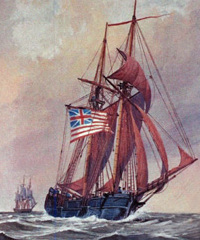
USS Wasp was originally a merchant schooner named Scorpion, built at Baltimore, and purchased under authority from the Second Continental Congress dated 2 December 1775 by Col. Benjamin Harrison sometime between 2 and 18 December 1775, the first US naval ship to be given that name. She was outfitted in Baltimore from December 1775 to early 1776; and commissioned in December 1775 or January 1776, Capt. William Hallock in command.

USS Reprisal, 18, was the first ship of what was to become the United States Navy to be given the name promising hostile action in response to an offense. Originally the merchantman brig Molly, she was purchased from Robert Morris by the Marine Committee of the Continental Congress on March 28, 1776, renamed Reprisal, and placed under the command of Captain Lambert Wickes.
Lambert Wickes was a captain in the Continental Navy during the American Revolutionary War.
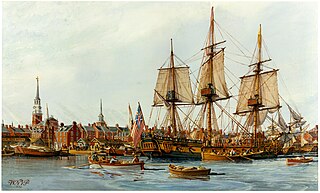
Alfred was the merchant vessel Black Prince, named for Edward, the Black Prince, and launched in 1774. The Continental Navy of what would become the United States acquired her in 1775, renamed her Alfred after 9th century English monarch Alfred the Great, and commissioned her as a warship. She participated in two major actions, the battle of Nassau, and the action of 6 April 1776. The Royal Navy captured her in 1778, took her into service as HMS Alfred, and sold her in 1782. She then became the merchantman Alfred, and sailed between London and Jamaica.
The first Dolphin was a cutter in the Continental Navy.

The Continental Marines were the amphibious infantry of the American Colonies during the American Revolutionary War. The Corps was formed by the Continental Congress on November 10, 1775 and was disbanded in 1783. Their mission was multi-purpose, but their most important duty was to serve as onboard security forces, protecting the captain of a ship and his officers. During naval engagements Marine sharpshooters were stationed in the fighting tops of the ships' masts, they would also man the cannons along with the crew of the ship and were supposed to shoot the opponent's officers, naval gunners and helmsmen.

The Raid of Nassau was a naval operation and amphibious assault by American forces against the British port of Nassau, Bahamas during the American Revolutionary War. The raid, designed to resolve the issue of gunpowder shortages, seized two forts and large quantities of military supplies before withdrawing back to New England, where they fought an unsuccessful engagement with a British frigate.

The history of the United States Marine Corps (USMC) begins with the founding of the Continental Marines on 10 November 1775 to conduct ship-to-ship fighting, provide shipboard security and discipline enforcement, and assist in landing forces. Its mission evolved with changing military doctrine and foreign policy of the United States. Owing to the availability of Marine forces at sea, the United States Marine Corps has served in nearly every conflict in United States history. It attained prominence when its theories and practice of amphibious warfare proved prescient, and ultimately formed a cornerstone of U.S. strategy in the Pacific Theater of World War II. By the early 20th century, the Marine Corps would become one of the dominant theorists and practitioners of amphibious warfare. Its ability to rapidly respond on short notice to expeditionary crises has made and continues to make it an important tool for U.S. foreign policy.
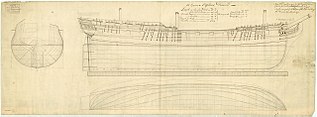
HMS Orpheus was a British Modified Lowestoffe-class fifth-rate frigate, ordered on 25 December 1770 as one of five fifth-rate frigates of 32 guns each contained in the emergency frigate-building programme inaugurated when the likelihood of war with Spain arose over the ownership of the Falkland Islands. Sir Thomas Slade's design for Lowestoffe was approved, but was revised to produce a more rounded midships section; the amended design was approved on 3 January 1771 by Edward Hawke's outgoing Admiralty Board, just before it was replaced. The contract to build the Orpheus was awarded to John Barnard at Harwich, the keel being laid in May 1771, and the frigate was launched 7 May 1773, at a cost of £12,654.16.11d. She sailed from Harwich on 24 May for Sheerness Dockyard, where she was completed and fitted out to the Navy Board's needs by 11 June.
William Bell Clark was an advertising executive and self-taught naval historian, specializing in the period of the American Revolution, 1775-1783.

Pierre Douville was a French-Canadian naval captain and lieutenant who served in the American Revolution and French Revolution. Born on present day Prince Edward Island, Douville survived the 1758 Acadian deportation to France. He joined the French Navy and lived in Rhode Island during the American Revolution. During the American Revolution, he served as a French military intelligence officer who provided General George Washington with British ship and troop movements. Douville also took part in a smuggling mission in 1775, when he brought weapons and gunpowder from the French West Indies to the United States. Douville was one of the original members of the Society of the Cincinnati. Douville died in 1794 fighting for the French during the Glorious First of June.
William Day was a Springfield, Massachusetts, sea captain who acted against America's enemies in both the French and Indian War and the American Revolutionary War. In 1777 he received the first gun salute to an American fighting vessel in a European port.

James Richard Dacres was an officer of the Royal Navy who saw service during the Seven Years' War, the American War of Independence and the French Revolutionary and Napoleonic Wars. He eventually rose to the rank of Vice-Admiral.

John Barry was an Irish-American officer in the Continental Navy during the American Revolutionary War and later in the United States Navy. He has been credited as "The Father of the American Navy" and was appointed a captain in the Continental Navy on December 7, 1775. He was the first captain placed in command of a U.S. warship commissioned for service under the Continental flag.

The Battle of Turtle Gut Inlet was an important, early naval victory for the Continental Navy and the future "Father of the American Navy", Captain John Barry. It was the first privateer battle of the American Revolutionary War. The battle resulted in the first American casualty of the war in New Jersey, Lieutenant Richard Wickes, brother of Captain Lambert Wickes. It was the only Revolutionary War battle fought in Cape May County.

Nancy was an American sailing vessel, noted in sources as either a brig or a brigantine, that was chartered to transport war supplies during the American Revolutionary War. After learning that independence had been declared, her captain, according to his daughter, raised the first American flag in a foreign port. Evading British capture, she was later intentionally destroyed with a huge blast on June 29, 1776, during the Battle of Turtle Gut Inlet near Cape May, New Jersey.
Hugh Montgomery was an American sea captain during the American Revolutionary War. He was commander of the brig Nancy, chartered to transport military supplies for the Americans. While loading cargo in the Caribbean, he learned that independence had been declared and raised the first American flag in a foreign port, according to his daughter. Returning to Philadelphia, he prevented the seizure of the cargo of gunpowder by British blockaders at the Battle of Turtle Gut Inlet on June 29, 1776. He was later captured by the British and died in 1780 returning from New Providence after his release.

HMS Kingfisher was the second ship in the 14-gun Swan class of ship sloops, to which design 25 vessels were built in the 1760s and 1770s. She was launched on 13 July 1770 at Chatham Dockyard, and completed there on 21 November 1770. She took part in the American Revolutionary War, enforcing the blockade of the Delaware Bay, and served in the Battle of Turtle Gut Inlet, near Cape May, New Jersey. While under the temporary command of Lieutenant Hugh Christian, she was burnt by her own crew to avoid capture on 7 August 1778 in Narragansett Bay during the Battle of Rhode Island.
